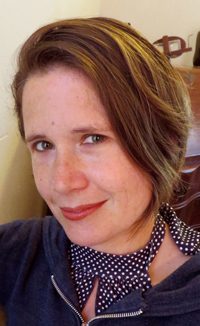Alexandra Teague’s The Wise and Foolish Builders walks us west through history. Sarah Winchester and the Winchester House Mystery stand as one of the collection’s foundations as the collection journeys, picking up voices—Annie Oakley, Buffalo Bill, Tennessee Williams, Houdini, and countless others, famous and common—as though hitching stories on to its back. Infatuated with history, the collection houses ghosts and questions innovation.
To be fully understood, one must first understand how and why the Winchester House was created. After Sarah Winchester was widowed, a Spiritualist told her “to move West and endlessly construct a house to appease (or house) the ghosts of everyone killed with Winchester rifles.” What is it to be left after a death? Sarah’s loss reverberates throughout until, in the final pages, Teague explores building as a sense of coping:
You’ll be alone
too young. You’ll need the veil like a gravestone:
a way to bury who you were: the naïve girl who
thought her house was built. Better to draw new
rooms he’s never lived in, staircases to any place
he maybe is.
There is a labor to constantly building. It is not unlike constructing ourselves again and again. It is circular, continuous, and consuming. Likewise, Teague’s poems are persistent. They add on to themselves, amend themselves as a builder would a house. They grow on one another through repetition. There are two poems titled “The Door To Nowhere,” two titled “How It Happened,” two titled “The House That Doesn’t Grow.” Whether mirroring the title of the poems or repeating phrases from one poem to another, repetition haunts this collection. Until the reader begins to question: haven’t I read this before? Because of the way the poems often double-back on themselves, becoming enlarged versions of their first self, the reader is much like one of the visitors walking through the Winchester House. In “Claims,” the italicized lines are the true words spoken by those who swore they saw a ghost:
A carpenter on a ladder
who doesn’t know you’ve died, he’s died—the clatter
of hammers hammering on. What I realized he was dead,
I turned to talk to him again but he was gone.
It is not unlike the effect Teague creates in her collection via mirroring and repetition. The reader is asked to go back, to look again, to make sure the prior version of the poem was in fact titled the same thing. Not only titles, but certain key phrases—such as “safe as houses”—are repeated. In “Stereoscope: Annie Oakley and Sarah Winchester,” Sarah Winchester states of her house:
How can I explain
its windows designed from guns:
levers and latches aimed at
the garden’s gazing ball
not for safety but because
that’s how I knew to build.
Underlying Teague’s collection is the question: Are houses safe? Why do we trust them so readily to hold us? Sarah Winchester, a few lines later, speaks to this:
—safe as houses
they say but what is safe about
this world with holes shot through and
with empty safes and chairs—this
dust and light on the piano, the smoke
Houses, too, can fall. Sarah Winchester’s house crumbled in an earthquake. The speaker’s own house flames to the ground in “Reconstruction.” Teague asks: What is safe about what we are building?
The Wise and Foolish Builders questions inventions and constructions. “The Blueprint” begins: “because the prophecy said build: this room / hinged to sky, a doorway, a sill, a step, a floor, / a chimney with nothing to burn” (83). Sarah Winchester built to house the souls killed by her father-in-law’s invention—the rifle. This concept ripples throughout, as Teague capitalizes on other inventions—the railroad in “Transcontinental,” the AK 47 in “Whole Cloth”—questioning their existence and whether the toil that brought them out from the mind to the earth was right. All the while the collection understands this is how America moved West to expand.
Beyond the historical connotations and foundations exists a speaker. With much of the collection moving backward in time in 1800 and 1900s, there are a series of poems from the first person point of view that propel the collection into present day. In “Fortune,” this speaker visits a palm reader. In “Range,” the speaker holds a gun “heavier / than it looked even unloaded, reloaded, the paper / swaying in the still air before me, not the end or / the beginning” (11). But perhaps “Reconstruction” most clearly ties the Winchester House Mystery with the terrifying truth of building having never entertained the consequences of building. “Reconstruction” therefore begins:
After our house, its thirteen rooms
and one hundred years, burned
to the ground, my mother said
she’d known it would happen.
Her premonitions leaned backwards
like shadows on the timothy grass…
The Wise and Foolish Builders wonders about the spirits that lurk—some believe—quite closely. Regardless if these spirits exist, they walk throughout Teague’s collection with strong legs like any man or woman. This book poses difficult questions regarding America’s expansion and the material inventions, particularly the gun, that achieved both foundation and ruin. As the speaker in “Range” holds the gun, but keeps her finger off the trigger, saying, “we / never know our own hands truly” (10).





